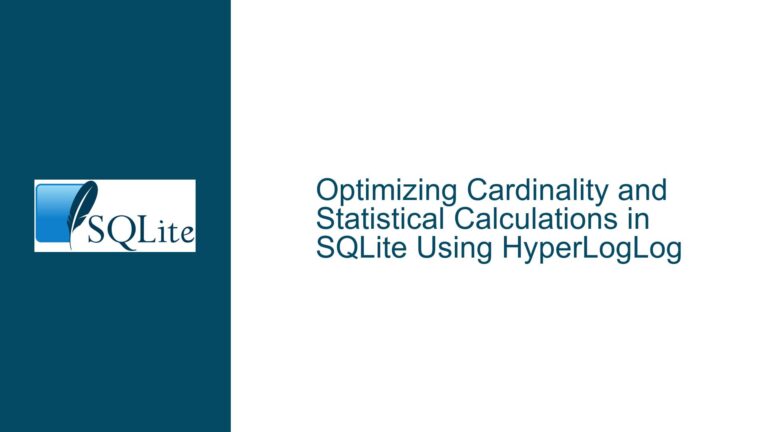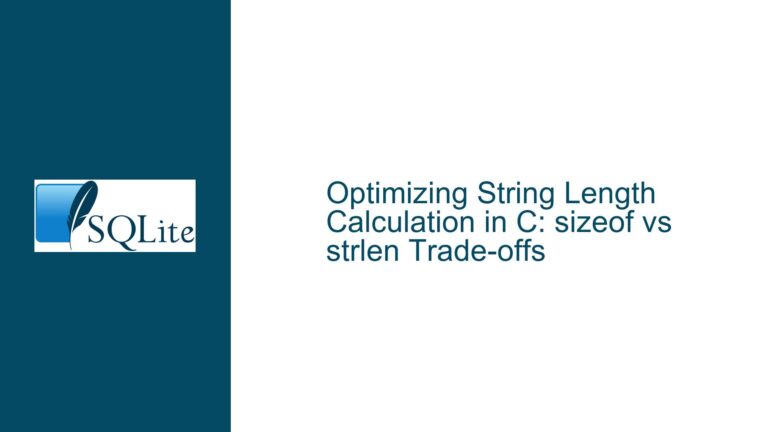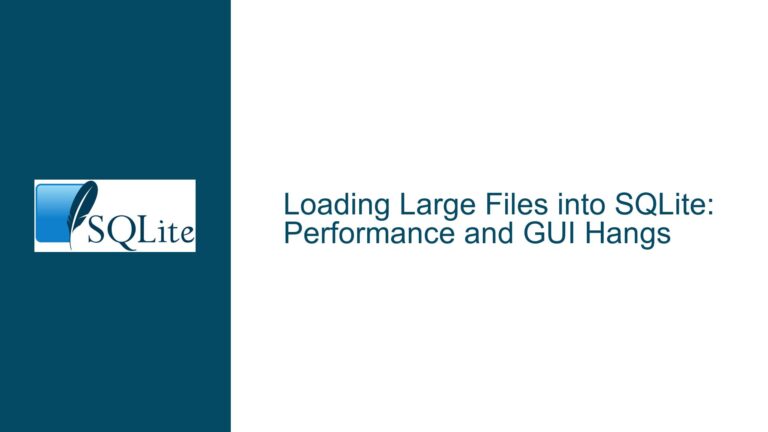Resolving SQLite Heap Memory Growth After Query Execution on Embedded Devices
Understanding Heap Memory Accumulation During SQLite Query Execution on Verix-Based Devices
The core issue revolves around persistent heap memory growth observed when executing SQLite queries via the sqlite3_exec() API on a Verifone C680 device running Verix OS. The application involves a C++ codebase that dynamically constructs SQL queries (SELECT and INSERT operations targeting 2,104 records), executes them using sqlite3_exec(), and processes results via a callback function. After repeated executions, the device’s heap memory utilization increases monotonically, raising concerns about memory leaks or inefficient memory management. Key technical elements include:
- Use of
sqlite3_exec()with dynamically generated queries containing user-provided parameters concatenated directly into the SQL string. - Global string buffers (e.g.,
strRowDataBufferFULL) modified within the callback function to accumulate result data. - Post-execution heap growth that does not return to baseline, even after closing the database connection.
- Device-specific constraints, including limited debugging tools (no Valgrind) and reliance on proprietary OS memory monitoring utilities.
The primary challenge lies in distinguishing between normal SQLite memory allocation patterns (e.g., internal caching, prepared statement reuse) and genuine memory leaks caused by application logic or SQLite configuration.
Root Causes of Unreleased Heap Memory in SQLite Applications
1. SQLite’s Memory Management Policies and Caching Mechanisms
SQLite employs a page cache, prepared statement cache, and temporary memory pools to optimize query execution. By default, it retains some heap memory after queries to avoid repeated allocation/deallocation overhead. This behavior is intentional and not a leak. However, on memory-constrained embedded systems like Verix OS, this retained memory can accumulate across queries, creating the illusion of a leak.
Key factors:
- Page Cache Retention: SQLite caches database pages in heap memory to accelerate future reads. The default cache size is 2,000 pages (adjustable via
PRAGMA cache_size). - Prepared Statement Recycling: While
sqlite3_exec()internally prepares, executes, and finalizes statements, SQLite may retain metadata (e.g., parsed query syntax trees) in memory for reuse. - Temporary Storage: Queries involving sorting, grouping, or transient tables allocate temporary heap memory, which is released gradually to avoid fragmentation.
2. Application-Side Memory Leaks in Callback Handling
The sqlite3_exec() API invokes a user-defined callback function for each result row. Errors in handling data within this callback can lead to heap growth:
- Unfreed SQLite-Managed Memory: If the callback or application code retains pointers to SQLite-allocated memory (e.g.,
argv[]strings), those buffers will not be released until the database connection closes. - Global/Static Buffer Misuse: The example code appends result data to a global
std::string(strRowDataBufferFULL). Repeatedly appending to a large string without pre-reserving capacity can cause frequent reallocations and heap fragmentation. - Error Message Leakage: The
errMsgparameter ofsqlite3_exec()dynamically allocates memory for error descriptions. Failing to callsqlite3_free(errMsg)after errors results in guaranteed memory leaks.
3. SQL Injection Vulnerabilities and Ad-Hoc Query Overhead
The code dynamically constructs SQL queries by concatenating user inputs (e.g., strWaybillNo, strTicketNo) into the query string. This approach:
- Exposes SQL Injection Risks: As noted by Richard Hipp, unsanitized input allows arbitrary SQL execution, which can trigger unintended memory-heavy operations (e.g., Cartesian joins, complex subqueries).
- Prevents Prepared Statement Reuse: Each unique query string (varying by input parameters) requires SQLite to parse, analyze, and generate a new execution plan, increasing heap usage.
4. Absence of SQLITE_ENABLE_MEMORY_MANAGEMENT
The SQLite library can be compiled with SQLITE_ENABLE_MEMORY_MANAGEMENT to enable aggressive heap trimming via sqlite3_db_release_memory() or sqlite3_release_memory(). If this compile-time option is disabled (the default), SQLite does not automatically return unused memory to the OS, relying on the application to trigger cleanup.
5. Device-Specific Memory Allocation Characteristics
Embedded systems like Verifone C680 often use custom memory allocators optimized for real-time performance over fragmentation avoidance. This can exacerbate heap growth when paired with SQLite’s allocation patterns.
Systematic Diagnosis and Mitigation of SQLite Heap Growth
Step 1: Confirm Whether a Memory Leak Exists
Objective: Differentiate between expected memory retention and genuine leaks.
Baseline Memory Usage:
- Use
sqlite3_memory_used()before and after each query execution to track SQLite’s internal allocations. - Compare memory deltas across identical query executions. Linear growth (e.g., +500 bytes per run) indicates a leak; stable deltas suggest caching.
- Use
Stress Testing:
- Execute the same query in a loop (100+ iterations). If heap growth plateaus after a few cycles, SQLite is retaining memory for reuse.
- Run a variety of dissimilar queries. If each new query type increases heap usage permanently, the schema or prepared statement cache may be bloated.
Cross-Platform Validation:
- Compile the application for Linux/Windows and run under Valgrind’s
memcheckor AddressSanitizer. These tools pinpoint exact leak locations (e.g., unfreederrMsg).
- Compile the application for Linux/Windows and run under Valgrind’s
Step 2: Eliminate SQL Injection and Ad-Hoc Query Overhead
Objective: Secure query generation and reduce parse/plan overhead.
Parameterized Queries:
Replace string concatenation with prepared statements and bound parameters:const char *sql = "SELECT ... WHERE bUploaded = 0 AND strWayBillNo = ? AND strTicketNo = ? AND intTripID = ?"; sqlite3_stmt *stmt; rc = sqlite3_prepare_v2(db, sql, -1, &stmt, NULL); sqlite3_bind_text(stmt, 1, strWaybillNo.c_str(), -1, SQLITE_STATIC); sqlite3_bind_text(stmt, 2, strTicketNo.c_str(), -1, SQLITE_STATIC); sqlite3_bind_int(stmt, 3, strTripID); while (sqlite3_step(stmt) == SQLITE_ROW) { // Process row } sqlite3_finalize(stmt);Benefits:
- Prevents SQL injection.
- Allows SQLite to reuse query plans, reducing parse overhead and heap churn.
Schema Optimization:
- Add
NOT NULL DEFAULTclauses to column definitions to eliminate redundantIFNULL()checks in queries. - Use
PRAGMA optimizeafter data changes to refresh query planner statistics.
- Add
Step 3: Audit and Fix Application Memory Handling
Objective: Ensure all SQLite-allocated memory is properly released.
Error Message Cleanup:
Always freeerrMsgaftersqlite3_exec():char *errMsg = NULL; int rc = sqlite3_exec(db, sql, callback, 0, &errMsg); if (rc != SQLITE_OK) { sqlite3_free(errMsg); // Critical }Callback Function Best Practices:
- Treat
argv[]pointers in the callback as ephemeral. Copy data immediately if needed later:std::string col1(argv[0] ? argv[0] : ""); // Copy to application-managed memory - Avoid global buffers. Pass a user-managed context to the callback:
struct CallbackContext { std::string buffer; }; CallbackContext ctx; sqlite3_exec(db, sql, [](void *ctx, int argc, char **argv, char **colNames) { static_cast<CallbackContext*>(ctx)->buffer.append(argv[0]); return 0; }, &ctx, &errMsg);
- Treat
Pre-Allocate String Buffers:
Reserve capacity instrRowDataBufferFULLto minimize reallocations:strRowDataBufferFULL.reserve(2048 * 40); // Pre-allocate for 40 rows
Step 4: Configure SQLite for Aggressive Memory Recycling
Objective: Force SQLite to relinquish unused heap memory promptly.
Enable Memory Management:
Recompile SQLite withSQLITE_ENABLE_MEMORY_MANAGEMENTand link the custom build into the application. This allows explicit heap trimming:sqlite3_db_release_memory(db); // Release memory from a specific connection sqlite3_release_memory(1024); // Attempt to free at least 1KB from all connectionsAdjust Cache Sizes:
Reduce SQLite’s in-memory caches to match the device’s constraints:PRAGMA cache_size = 500; -- Default: 2000 pages (~1.5MB for 4KB pages) PRAGMA temp_store = MEMORY; -- Default: 0 (mix of heap and temp files)Periodic Maintenance:
After bulk operations or transaction commits, manually shrink memory:sqlite3_db_config(db, SQLITE_DBCONFIG_RESET_DATABASE, 1, 0); sqlite3_exec(db, "VACUUM", NULL, NULL, NULL);
Step 5: Device-Specific Debugging and Heap Analysis
Objective: Work around Verix OS tooling limitations to isolate leaks.
Instrumentation Hooks:
- Override
malloc()/free()with logging wrappers to track allocations. - Use Verix’s heap monitoring APIs to dump allocation statistics before/after queries.
- Override
Minimal Reproducible Example:
Extract the SQLite interaction into a standalone Verix application that:- Opens a database.
- Executes a parameterized query in a loop.
- Closes the database and measures heap usage.
Compare this against a control app without SQLite to isolate the component causing growth.
Cross-Compilation for Linux:
Build the test application for x86 Linux with Verix’s toolchain. Run undervalgrind --leak-check=fullto identify leaks that may also exist on the device.
Step 6: Long-Term Monitoring and Optimization
Objective: Maintain stable heap usage across the application lifecycle.
Query Efficiency Analysis:
UseEXPLAIN QUERY PLANto audit the generated SQL for full table scans, unnecessary sorts, or inefficient indexes. Heap usage often correlates with query complexity.Connection Pooling:
Reuse database connections instead of opening/closing them frequently. Each connection maintains its own cache, so pooling reduces overhead.Memory Profiling:
Integrate SQLite’s internal memory tracking into the application:printf("SQLite memory used: %lld\n", sqlite3_memory_used()); printf("Highwater mark: %lld\n", sqlite3_memory_highwater(0));Fragmentation Mitigation:
Prefer static or pre-allocated buffers for result processing. On embedded systems, fragmented heaps can prevent SQLite from reusing freed blocks, causing apparent growth.
By methodically addressing SQL injection risks, enforcing rigorous memory hygiene, reconfiguring SQLite’s memory policies, and leveraging platform-specific diagnostics, developers can mitigate heap growth issues even on constrained embedded platforms like Verix OS. The key is to first rule out application-side leaks and query inefficiencies before adjusting SQLite’s internals.






